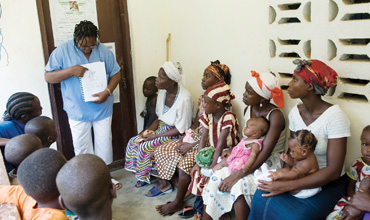Improving Health Systems in Nigeria

Abstract:
Nigeria, with a population of 140 million people accounting for
47% of the population of West Africa, has a moral responsibility to lead the
continent towards achieving the Millennium Development Goals (MDGs). Yet its
health system is ranked 187th of 191 WHO member states. Lending credence to
this ranking are health indices such as an infant mortality rate of 101 per
1000; maternal mortality rates ranging from 500 per 100,000 in the South West
to 800 per 100,000 in the North East, perinatal mortality rate of 48 per 1000
and child mortality rate of 205 per 1000.
There is thus an urgent need to foster effective
collaboration and partnership with all relevant stakeholders to improve the health systems in Nigeria.
This paper explores challenges and possible solutions relating
to health systems strengthening in Nigeria including health policies,
governance, organization and financing of health services, health workforce
production and health service delivery.
References:
[1.] Bennett S and Gilson L. 2001. Health Financing:
designing and implementing pro-poor policies, DFID Health Systems Resource
Centre.
[2.] Cassels A., Janovsky K. 1998. Better health in
developing countries: are sector-wide approaches the way of the future? The
Lancet, 1998, 352:1777–1779.
[3.] Chernichovsky C. 2000. The Public-Private Mix in
the Modern Health Care System - Concepts, Issues, and Policy Options Revisited.
Ben-Gurion University of the Negev and NBER.
[4.] Department for International Development. 2005.
From commitment to action: Health.
[5.] Disease Control Priorities Project 2. Strengthening
Health Systems Chapter 3. 2006 The International Bank for Reconstruction and
Development / The World Bank.
[6.] Enugu State District Health Management Information
System 2007.
[7.] Kelly G and Nwobodo E. 2004. Developing the
district health system in Enugu State. DFID- PATHS Consultancy Report.
[8.] Federal Government of Nigeria. 1997. Report of the
vision 2010 Committee - Main Report. Abuja: Federal Government of
Nigeria.
[9.] Federal Ministry of Health. 2004. Health Sector
Strategic Development and Reforms Initiatives for Nigeria. Abuja Annex 1(a)
[10.] Federal Ministry of Health.1988.The National Health
Policy and Strategy to Achieve Health for All Nigerians. Lagos: FMOH.
[11.] Federal Office of Statistics. 2004. Core Welfare
Indicators Questionnaire Survey: Combined 6-States Main Report. Abuja, FOS,
State Statistical Agencies of Abia, Cross River, Gombe, Kebbi, Osun, and
Plateau: pg. 16-20.
[12.] Federal Republic of Nigeria. 1981. Fourth National
Development Plan 1981-85. Lagos: The National Planning Office, Federal
Ministry of National Planning, 272-287.
[13.] Federal Republic of Nigeria.1979. The Constitution
of the Federal Republic of Nigeria. Enugu: Government Printing Department.
[14.] Federal Republic of Nigeria.1999. The Constitution
of the Federal Republic of Nigeria. Abuja: Government Printing Department.
[15.] Federal Office of Statistics. 2004. Nigeria Living
Standard Survey (NLSS) 2003/2004, Pg. 35-39. Abuja: FOS, European Union, World
Bank, Department of International Development, UNDP. p. 35-39.
[16.] Health Policy Review and Harmonization with Health
Legislation in Nigeria, Oct. 2003. Change Agents Program. Vol. 15.
[17.] Ityavyar D. 1987. “Background to the Development of
Health Service in Nigeria”. Social Science and Medicine. 27: 1223-35.
[18.] McIntyre D. 2005. Removing User Fees for Primary Care
in Africa: The need for careful action. British Medical Journal 331:
762-765.
[19.] National Health Insurance Scheme Act 35 of 1999.
[20.] NHIS Handbook 2006.
[21.] NHIS Operational Guidelines, October 2005
[22.] OAU. 2001. Abuja Declaration on HIV/AIDS, tuberculosis
and other related infectious diseases. Organisation of African Unity.
[23.] Ogunbekun I., Adeyi O, Wouters A, Morrow R.H. 1996.
“Costs and financing of improvements in the quality of maternal health services
through the Bamako initiative in Nigeria. Health Policy and Planning. 11:
369-84.
[24.] Olaniyan R.O.. 1995. “Managing Health Development in
Nigeria”. Nigeria Journal of Health Planning and Management. 1 (1)
July-December, 31-35.
[25.] Raufu A. 2002. Nigerian health authorities worry over
exodus of doctors and nurses. BMJ 2002; 325:65.
[26.] Russell S. 1996. Ability to pay for Health Care:
Concepts and Evidence, “Health Policy and Planning; 11 (3) 219-237.
[27.] Sanders J. 2002. “Financing and organization of
National Health Systems”. World Health Systems: Challenges and Perspectives.
Eds Bruce Fried and Laura Gaydos (Eds.). Chicago: Health Administration Press.
[28.] Sattman R.B, Ferroussier - Davis O. 2000: On the
concept of stewardship in health policy. Bulletin of the World Health
Organisation, 78(6): 732-739.
[29.] Soyibo A. 2003. “Health Sector Public Expenditure Review”:
Final Report Submitted to the National Planning Commission and World Bank,
Abuja.
[30.] Schram R. 1971. A History of Health Service in
Nigeria., Ibadan: University of Ibadan Press.
[31.] SWAP - A sector-wide approach (SWAP) is a method of
working that brings together governments, donors, communities and other
stakeholders within any sector.
[32.] Velenyi E. 2005. In Pursuit of More and Better Managed
Funds: Policy Options to Purchase Better Health for Nigeria: A Feasibility
Study of the National Health Insurance Scheme of Nigeria. The World Bank.
[33.] World Health Organization, 1988. Challenge of
implementing district health system or primary care. WHO, Geneva.
[34.] WHO. 2005. Basic Statistics from the Health for Al
l(HFA) database.
[35.] WHO, World Health Report 2000. WHO, Geneva.
[36.] WHO, World Health Report 2005. WHO, Geneva.
[37.] WHO, World Health Report 2007. WHO, Geneva.
[38.] World Health Organization, 2000. 78(6) (cross
reference)
[39.] World Bank. 2003. World Development Indicators.
[40.] World Bank Group, 2006. Health Financing Systems in
Disease Control Priorities in Developing Countries, Second Edition.

